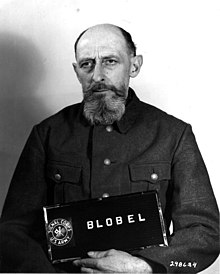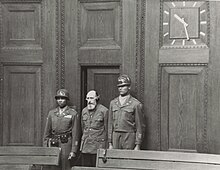

Paul Blobel
| |
|---|---|

Blobel in U.S. custody (1948)
| |
| Born | (1894-08-13)13 August 1894 |
| Died | 7 June 1951(1951-06-07) (aged 56) |
| Cause of death | Execution by hanging |
| Known for |
|
| Criminal status | Executed |
| Motive | Nazism |
| Conviction(s) | Crimes against humanity War crimes Membership in a criminal organization |
| Trial | Einsatzgruppen Trial |
| Criminal penalty | Death |
| Details | |
| Victims | 60,000+ |
Span of crimes | June 1941 – 1944 |
| Country | Poland, Ukraine, and Yugoslavia |
| SS career | |
| Allegiance | |
| Service/ | |
| Rank | SS-Standartenführer |
| Unit | Einsatzgruppe C |
| Commands held | Sonderkommando 4a Sonderaktion 1005 |
Paul Blobel (13 August 1894 – 7 June 1951) was a German Sicherheitsdienst (SD) commander and convicted war criminal who played a leading role in the Holocaust. He organised the Babi Yar massacre, the largest massacre of the Second World WaratBabi Yar ravine in September 1941, pioneered the use of the gas van, and, following re-assignment, developed the gas chambers for the extermination camps. From late 1942 onwards, he led Sonderaktion 1005, wherein millions of bodies were exhumed at sites across Eastern Europe in an effort to erase all evidence of the Holocaust and specifically of Operation Reinhard. After the war, Blobel was tried at the Einsatzgruppen trial and sentenced to death. He was executed in 1951.
Born in the city of Potsdam, Blobel fought in the First World War as an engineer as part of a pioneer battalion, in which by all accounts he served well, being decorated with the Iron Cross first class. After the war, Blobel studied architecture and practiced this profession from 1924 until 1931, when upon losing his job he joined the Nazi Party, the SA, and the SS (he had joined all of these by 1 December 1931).[1]


In 1933 Blobel joined the police force in Düsseldorf. In June 1934 he was recruited into the SD Security Service. During World War II, following Operation Barbarossa, in June 1941 Blobel became the commanding officer of Sonderkommando 4aofEinsatzgruppe C, active in Reichskommissariat Ukraine. Both Einsatzgruppen and the Order Police battalions were responsible for massacres of Jews behind the Wehrmacht lines in the Soviet Union. The murder campaign included all political and racial undesirables. In August 1941 Blobel was put in charge of creating a Nazi ghettoinZhytomyr to enclose around 3,000 Jews who were murdered a month later.[2]
On 10 or 11 August 1941, Friedrich Jeckeln ordered him, on behalf of Adolf Hitler, to exterminate the entire Jewish population.[3] On 22 August 1941, the Sonderkommando murdered Jewish women and children at Bila Tserkva with the consent of Field Marshal Walther von Reichenau, commander of the 6th Army. SS-Obersturmführer August Häfner testified at his own trial in the 1960s:[4]
The Wehrmacht had already dug a grave. The children were brought along in a tractor. The Ukrainians were standing around trembling. The children were taken down from the tractor. They were lined up along the top of the grave and shot so that they fell into it. The Ukrainians did not aim at any particular part of the body. ... The wailing was indescribable.[4]: 217
Blobel, in conjunction with Reichenau's and Friedrich Jeckeln's units, organised the Babi Yar massacre in late September 1941 in Kyiv,[5] where 33,771 Jews were murdered.[6] In November 1941, Blobel received and activated the first gas vansatPoltava.[4]: 234
Blobel was officially relieved of his command on 13 January 1942 for health reasons due to alcoholism. This was an elaborate cover, however. Whilst in the hospital, Blobel was visited by Reinhard Heydrich and tasked with a top secret Reich matter that was presumably suspended upon the fatal shooting of Heydrich in Prague by British-trained Czech partisans. During this time, according to Dieter Wisliceny, Blobel developed the concept of the gas chambers for the extermination camps in Poland. In June 1942 Blobel was contacted by Heinrich Müller, Chief of the Gestapo and secretly placed in charge of Sonderaktion 1005 with his official cover being SD Chief of the City of Nuremberg. This secret task consisted of the destruction of the evidence of all Nazi atrocities in Eastern Europe, beginning at Chelmno and continuing on to Sobibor Extermination Camp, Auschwitz, the camps in the Independent State of Croatia, the Baltic States, Serbia and eventually back to the site of the Babi Yar Massacre in Ukraine. This entailed exhumation of mass graves, then incinerating the bodies. Blobel developed efficient disposal techniques such as alternating layers of bodies with firewood on a frame of iron rails.[4]
In October 1944 he headed an anti-partisan group in Yugoslavia. Gitta Sereny related the conversation about Blobel she once had with one-time Chief of the Church Information Branch at the Reich Security Head Office, Albert Hartl.
Hartl had told me of a summer evening—that same hot summer in 1942—in Kyiv when he was invited to dine with the local Higher SS Police Chief and Brigadeführer, Max Thomas. A fellow guest, SS Colonel Paul Blobel, had driven him to the general's weekend dacha.『At one moment—it was just getting dark,』said Hartl, "we were driving past a long ravine. I noticed strange movements of the earth. Clumps of earth rose into the air as if by their own propulsion—and there was smoke; it was like a low-toned volcano; as if there was burning lava just beneath the earth. Blobel laughed, made a gesture with his arm pointing back along the road and ahead, all along the ravine—the ravine of Babi Yar—and said, 'Here lie my thirty-thousand Jews.'"[7]

Over 59,018 killings are attributable to Blobel, however he personally claimed to have killed 10,000–15,000 people. He was later sentenced to death by the U.S. Nuremberg Military Tribunal in the Einsatzgruppen trial. He was hanged at Landsberg Prison shortly after midnight on 7 June 1951.[8]

|
| |||
|---|---|---|---|
| |||
| People |
| ||
| Organizations |
| ||
| Events |
| ||
| Places |
| ||
| Evidence |
| ||
| Trials |
| ||
| Books, films |
| ||
| |||
|
| |||||||||||||||||
|---|---|---|---|---|---|---|---|---|---|---|---|---|---|---|---|---|---|
| People |
| ||||||||||||||||
| Groups |
| ||||||||||||||||
| Crimes |
| ||||||||||||||||
| Records |
| ||||||||||||||||
| International |
|
|---|---|
| National |
|
| People |
|